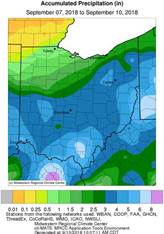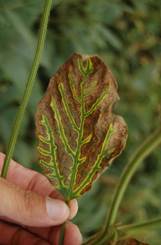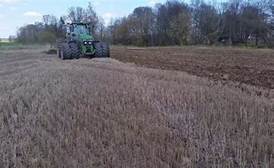Hello,
I hope that you had the opportunity to get out to the Hardin County Fair this past week. Now that the fair is over for this year, the next big event on the calendar is the Farm Science Review. We still have tickets for sale at the Extension office through Monday for $7 per person. $1 of that total stays in the county and if you wait until the day of the Farm Science Review on September 18-20, you will have to pay $10 at the gate. The Farm Science Review has increased its size this year, enclosing the Ag Crops Team plots and surrounding area for the ride and drive part of the show. If you are planning to attend this year’s FSR Tuesday-Thursday of next week, make sure you stop by this new section of the exhibit area. I will be doing a presentation on Nitrogen Management in Corn in the Small Farm Center Building on Thursday at 10:30 so see the attached poster for details if you are interested.
Farm Science Review Nitrogen in Corn
According to the USDA, corn is rated 79% good to excellent and soybeans are rated up to 80% good to excellent according to the latest Ohio Crop Weather Reports. I have attached both the September 4th and September 10 reports for you to read more about Ohio’s crop progress. I noticed one soybean field partially harvested here locally and they have begun to open up the fields at the Molly Caren Agricultural Center in London in preparation for this year’s Farm Science Review. Rain continues to fall here in Hardin County with 4.78 inches recorded in August and 19.60 inches for the growing season as of April 15. See the attached August 2018 Rainfall Summary for more information about how the rainfall has affected crops.
Ohio Crop Weather Report September 4
Ohio Crop Weather Report September 10
August 2018 Rainfall Summary News Release
Hardin County Agriculture Hall of Fame nominations are being collected for 2018. This year’s Ag Hall of Fame Banquet is scheduled for Tuesday, December 4 with nominations due to the Extension office by October 15. Nominees must have made their major contribution to agriculture primarily as a result of being born, growing up, living in, or working in Hardin County, Ohio. Outstanding agriculturalists may be nominated by individuals or organizations. Please take a look at the attached news release and nomination form and encourage someone you know to nominate a family member or individual you believe is worthy of this honor. Often times people are too humble to nominate themselves, so all it takes is a little encouragement to get the person properly recognized.
Ag Hall of Fame Nominations News Release
Ag Hall of Fame Purpose and Nomination Form
The Natural Resources Conservation Service (NRCS) has announced a new sign-up deadline for its Environmental Quality Incentives Program (EQIP). The local NRCS office is currently planning for the next crop year, and this October 19, 2018 deadline applies to the 2019 crop year. EQIP is a very popular and important program for Hardin County farmers and landowners. In 2018, Hardin County NRCS obligated 22 contracts for more than $1.7M. Currently Hardin County has 50 active EQIP contracts for almost $6M. Stop by the Hardin Ag Service Center and see Megan Burgess for more details. I have attached a copy of the news release which will provide more information about the procedure.
Environmental Quality Incentives Program News Release
Upcoming events include a Pumpkin Disease Diagnosis Field Night October 3 in Piketon. See the attached flyer for more information. Locally, Ag Council will be meeting for breakfast tomorrow morning (9/14) starting at 7:00 am in Henry’s Restaurant to discuss waterhemp and Palmer amaranth along with other topics; Ada Harvest and Herb Festival is Saturday (9/15); Hardin Soil and Water Conservation District is meeting Thursday (9/20) starting at 7:30 am in the SWCD office; and the Farm Bureau ATV Tour is being held in combination with Van Scoy Farms ‘Feast on the Farm’ Sunday (9/23). I have included some Ag Crops articles for you to read as we wait for the crops to be ready for harvest.
Pumpkin Disease Diagnosis Field Night Flyer
Mark
Tropical Moisture Invades Ohio – Aaron Wilson
It was quite the wet week across the state of Ohio! Scattered thunderstorms throughout the week brought isolated 1-2” rainfall amounts. The big story began on Friday night, as a stalled out front provided a path for the remnants of Tropical Storm Gordon to move through the region, bringing steady to moderate rain and gusty winds from Friday night through Monday morning. While rainfall was certainly heaviest across the southern counties of Ohio this weekend, almost the entire state picked up appreciable amounts of rain. Go to https://agcrops.osu.edu/newsletter/corn-newsletter/2018-30/tropical-moisture-invades-ohio to read more about the weather.
Farm Science Review is September 18, 19 & 20 – Harold Watters
The Farm Science Review this year is September 18, 19 and 20 at the London, Ohio location. The parking lots have been reworked, seeded and improved over the past year with more gravel areas added. Drainage has also been improved in the exhibit area to fasten water removal – all to give you a better experience. Tickets can be purchased from your local Extension office and from many ag retailers, or go on-line to the FSR website: https://fsr.osu.edu/onlineticketform. A repeat this year, the Farm Science Review app will help you find and locate what it is you are looking for – look for “Farm Science Review 2018” on Google Play or the Apple App stores. Finish reading this article at https://agcrops.osu.edu/newsletter/corn-newsletter/2018-30/farm-science-review-september-18-19-20.
Wheat Management for Fall 2018 – Laura Lindsey, Pierce Paul, Ed Lentz
Wheat helps reduce problems associated with the continuous planting of soybean and corn and provides an ideal time to apply fertilizer in July/August after harvest. With soybean harvest around the corner, we would like to remind farmers of a few management decisions that are important for a successful crop. For additional information on winter wheat management, download a free pdf of the Ohio Agronomy Guide available here:https://stepupsoy.osu.edu/wheat-production/ohio-agronomy-guide-15th-edition. To read the rest of this article, go to https://agcrops.osu.edu/newsletter/corn-newsletter/2018-29/wheat-management-fall-2018.
Early Yellowing Soybeans – Anne Dorrance
Soybeans across the state range from ready to harvest to still flowering. But in some fields, the yellowing was limited to pockets – some was sudden death syndrome or brown stem rot, charcoal rot, Phytophthora stem rot, and soybean cyst nematode. There are some other early yellowing situations that we are still working on an accurate diagnosis, but yellowing in these cases may be linked to fertility issues and/or related to late flooding injury. To read more, click on https://agcrops.osu.edu/newsletter/corn-newsletter/2018-29/early-yellowing-soybeans.
Mexican Bean Beetles Make an Appearance – Kelley Tilmon, Andy Michel, Clifton Martin
Though less common than it once was, the Mexican bean beetle still maintains a presence in Ohio, and we have been getting a few reports of economic populations in soybean this month, largely in the east-central part of the state. The Mexican bean beetle adult is a small, copper-colored beetle with numerous black spots, while the larva (immature) is yellow with black spines. The adult beetle resembles a ladybeetle because they are members of the same insect family, Coccinellidae. Mexican bean beetles are one of the few members of this family that are plant pests. Go to https://agcrops.osu.edu/newsletter/corn-newsletter/2018-28/mexican-bean-beetles-make-appearance to finish reading this article.
Mark A. Badertscher
Agriculture and Natural Resources Educator
OSU Extension Hardin County
1021 W. Lima Street, Suite 103, Kenton, OH 43326
419-674-2297 Office











